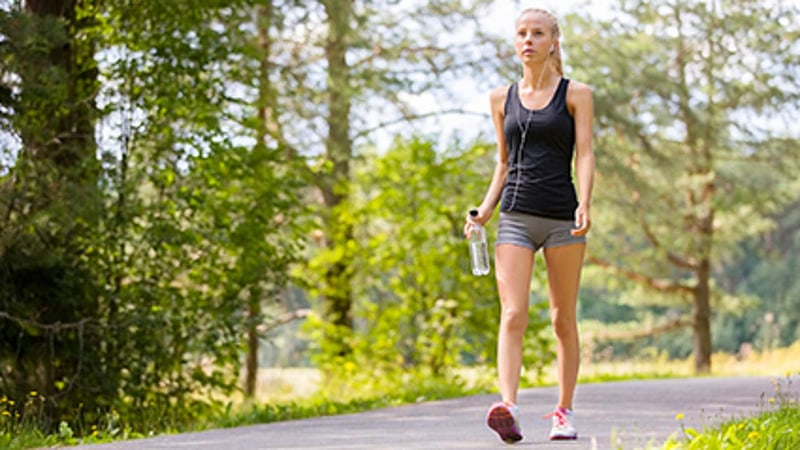Get Healthy!

- Cara Murez
- Posted January 30, 2023
Step Up! Here's How to Start a Healthy Walking Habit
Starting a walking routine is simple because it requires so little: comfortable, supportive walking shoes and your own two feet.
Unlike gym workouts, the initial expense is small and the schedule is flexible.
"Walking's a great way to work out because we can integrate it into our daily lives,"said Amanda Paluch, an assistant professor in the department of kinesiology and Institute for Applied Life Sciences at the University of Massachusetts, Amherst.
"And if you can just fit it around your house or within your neighborhood, it's one of the most convenient options,"Paluch said.
The benefits abound, too.
Even a single bout of walking at a moderate-to-vigorous intensity can improve sleep, memory, ability to think and anxiety, according to the U.S. Centers for Disease Control and Prevention.
Harvard Health noted some surprising benefits, including that walking can reduce sugar cravings, ease joint pain, boost immunity, counteract obesity genetics and reduce breast cancer risk.
More well-known benefits include lowering high blood pressure and the risk for type 2 diabetes, helping someone maintain a healthy body weight and strengthening the musculoskeletal system, according to Colorado State University.
A Texas clinical trial credited a half-hour of power walking or jogging five times weekly with better blood flow in and out of the brain in research published in the Journal of Applied Physiology.
"Taking just a few more steps per day, that's a great way to get started. A walking program is really nice because it fits a very broad population,"Paluch said.
Does it matter whether you walk outside or on a treadmill?
"Both will provide similar benefits so, the best option between treadmill vs. track is the one you enjoy doing and have regular/easiest access to, and will therefore be the best option to help you stick with your walking routine," Paluch said.
Answers to top walking questions
Breaking up a longer workout into shorter "bouts"of activity can be helpful for beginners, Paluch suggested.
Think about where you are physically, and then progressively increase your walking time from there, Paluch advised.
You might wear a step-counting device for a few days to figure out your baseline steps. Say, it's about 4,000, which is common, then add about 500 more steps per day for the next week, she suggested.
"Just think about trying to make each increase a habit, right? So, we don't want to just jump into it and say, we're going to go out and walk five miles,"Paluch said. "Our goals become more achievable when we think about those in bite-size pieces and, also, we prevent injury."
Walking at a moderate-to-vigorous intensity is more helpful for someone wanting to incorporate walking into a weight-loss plan, she added.
A 150-pound person who walks briskly will burn about 297 calories per hour, according to the American Cancer Society (ACS).
How many calories can you burn during a 40-minute walk? According to Livestrong, you can burn between 160 calories and 296 calories, depending on your weight and walking speed.
Walking more is best, the ACS suggested, citing a recent study published in the Journal of the American Medical Association. That study found more steps were linked to lower death rates from heart disease and cancer.
Mayo Clinic offers tips on starting a 12-week walking schedule, suggesting five minutes of slower-paced walking at the beginning and again at the end of a walking workout to warm up and cool down. It recommends five walking days per week.
A brisk walk means you're breathing hard, but can still talk, the Mayo Clinic noted. A moderate intensity walk means you can walk, but can't sing, Paluch said.
A faster pace appears to be important for good health. Harvard Health noted that regular walking reduced risk of heart disease and early death, especially for those who walked at a pace of 3 miles an hour or faster.
University of California, Berkeley, offers some tips on walking techniques.
Shoulders should be relaxed. Your head should be upright with your chin in a neutral position. Feet should be close to an imaginary line in the center of the pavement ahead of you.
The heel should strike first. One foot should always be on the ground. Swinging bent arms with each step will burn 5% to 10% more calories.
UC Berkeley, suggests finding stride length with a move like a ski jumper. Lean forward at the ankles and then step with your right food forward to catch yourself before falling. That's the proper stride length for you.
Strategies to keep your routine on track
Paluch offered some tips for not losing ground with your walking workout:
- Keep your walking shoes close by. "The idea is to try to eliminate the barriers as much as possible,"Paluch said.
- On a busy day, walk a few flights of stairs instead of a more typical workout. It all counts.
- Don't feel defeated if you miss a day. "When we can't get it all, get at least some and that will continue to help with habit formation,"Paluch said.
SOURCE: Amanda Paluch, assistant professor, department of kinesiology, and Institute for Applied Life Sciences, University of Massachusetts, Amherst




